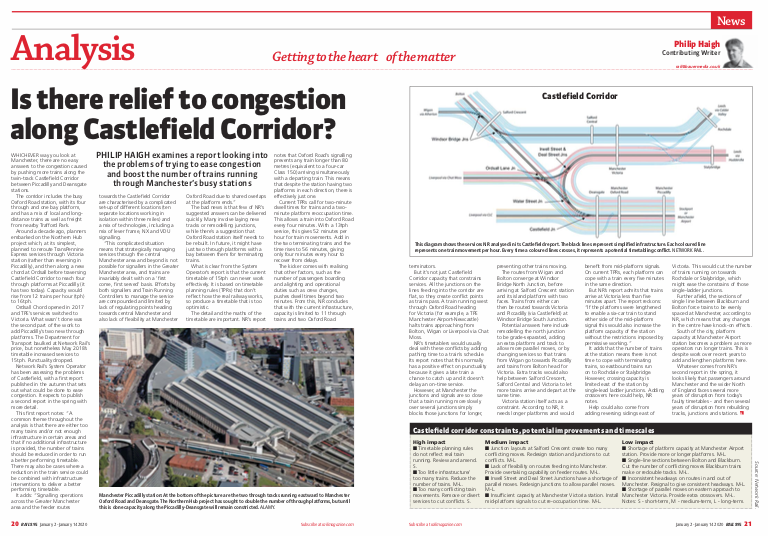Whichever way you look at Manchester there are no easy answers to the congestion caused by pushing more trains along the twin-track Castlefield Corridor between Piccadilly and Deansgate stations.
The corridor includes the busy Oxford Road station with its four through and one bay platform. It sees a mix of local and long-distance trains as well as freight from nearby Trafford Park.
Around a decade ago, planners embarked on the Northern Hub project which, at its simplest, planned to reroute TransPennine Express services through Victoria station (rather than reversing in Piccadilly) and along a new chord at Ordsall before traversing Castlefield corridor to reach four through platforms at Piccadilly (it has two today). This plan would boost capacity from 12 trains per hour (tph) to 16tph.
Ordsall Chord opened in 2017 and TPE switched services to Victoria. Work stopped before adding the second part of the project to add Piccadilly’s two new through platforms. The Department for Transport baulked at Network Rail’s price but nonetheless May 2018’s timetable increased services to 15tph. Punctuality dropped.
First report explains problem
Network Rail’s System Operator assessed Castlefield and published a first report in autumn 2019 that explains potential answers. It pledged a second report in spring 2020 with more detail.
This first report notes: “A common theme throughout the analysis is that there are either too many trains and/or not enough infrastructure in certain areas and that if no additional infrastructure is provided, the number of trains should be reduced in order to run a better performing timetable. There may also be cases where a reduction in the train service could be combined with infrastructure interventions to deliver a better performing timetable.
It adds: “Signalling operations across the Greater Manchester area and the feeder routes towards the Castlefield Corridor are characterised by a complicated set up of different locations (ten separate locations working in isolation within three miles) and a mix of technologies, including a mix of lever frame, NX and VDU signalling.
“This complicated situation means that strategically managing services through the central Manchester area and beyond is not possible for signallers in the Greater Manchester area, and trains are invariably dealt with on a ‘first come, first served’ basis. Efforts by both signallers and Train Running Controllers to manage the service are compounded and limited by lack of regulating points heading towards central Manchester and also lack of flexibility at Manchester Oxford Road due to shared overlaps at the platform ends.”
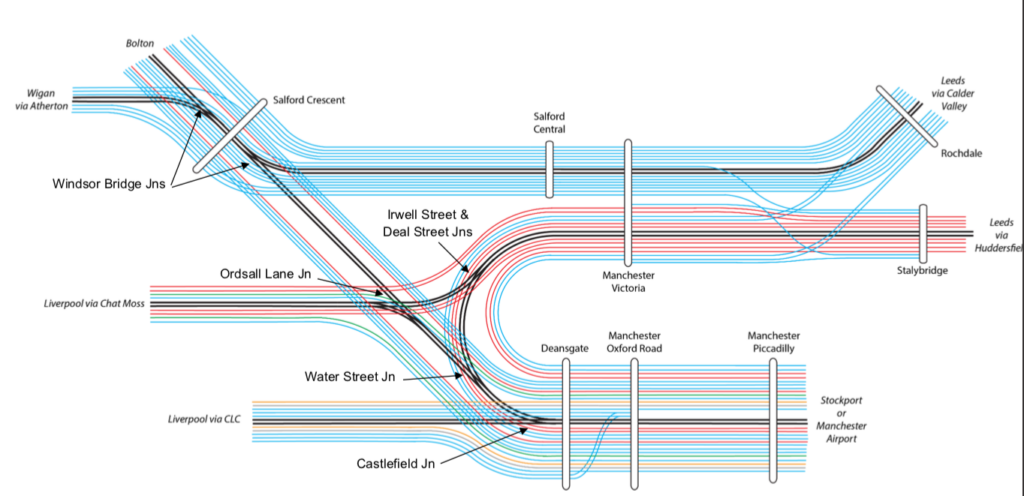
No quick answers for Castlefield
The bad news is that few of NR’s suggested answers can be delivered quickly. Many involve laying new tracks or remodelling junctions and there’s a suggestion that Oxford Road station itself needs to be rebuilt. In future, it might have just two through platforms with a bay between them for terminating trains.
The System Operator’s report makes clear that the current timetable of 15tph can never work effectively. It uses timetable planning rules (TPRs) that don’t reflect how the real railway works. This produces a timetable that is too optimistic.
The detail and the maths of timetable are important. NR’s report notes that Oxford Road’s signalling prevents any train longer than 80m (equivalent to a four-car Class 150) arriving simultaneously with a departing train. This means that despite the station having two platforms in each direction, there is effectively just one. Current TPRs call for two-minute dwell times for trains and a two-minute platform reoccupation time. This allows a train into Oxford Road every four minutes. With a 13tph service, this gives 52 minutes per hour for train movements. Add in the two terminating trains and the time rises to 56 minutes, giving only four minutes every hour to recover from delays.
The kicker comes with realising that other factors such as the number of passengers boarding and alighting and operational duties such as crew changes pushes dwell times beyond two minutes. NR concludes that, with the current infrastructure, capacity is no more than 11 through trains and two Oxford Road terminators.
Problems extend beyond Castlefield
It’s not just Castlefield Corridor capacity that constrains services. All the junctions on the lines feeding into the corridor are flat so they create conflict points as trains pass. A train running west through Oxford Road heading for Victoria (for example, a TPE Manchester Airport-Newcastle train) halts trains approaching from Bolton, Wigan or Liverpool via Chat Moss.
NR’s timetablers would usually deal with these conflicts by adding pathing time to a train’s schedule. Its report notes that this normally has a positive effect on punctuality because it gives a late train a chance to catch up and it doesn’t delay an on-time service. However, at Manchester the junctions and signals are so close that a train running more slowly over several junctions blocks those junctions for longer, preventing other trains moving.
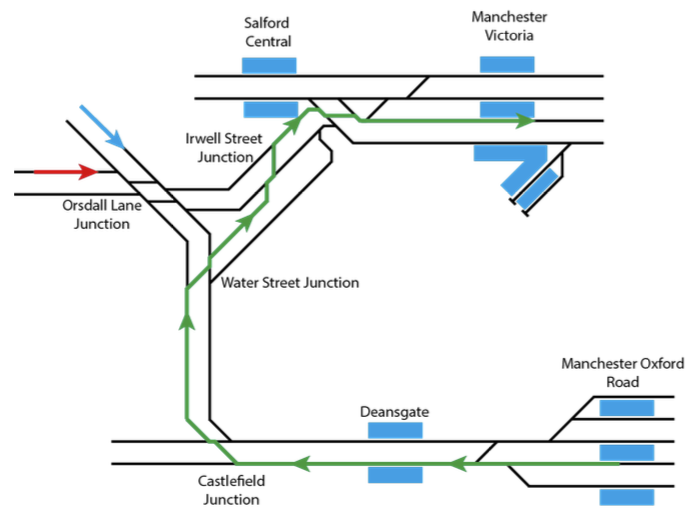
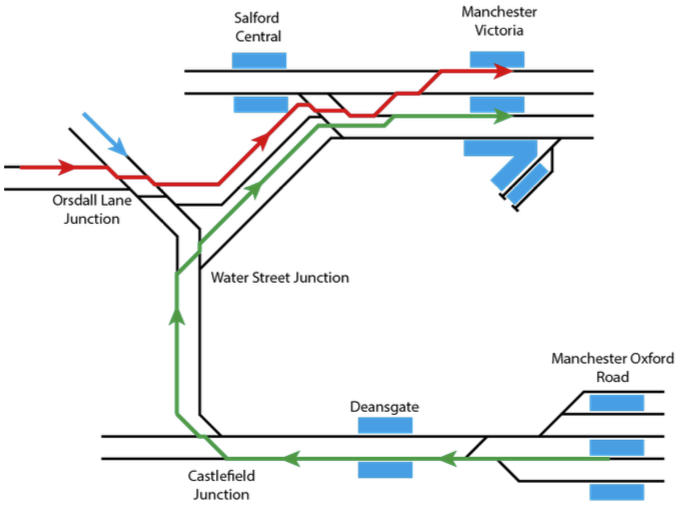
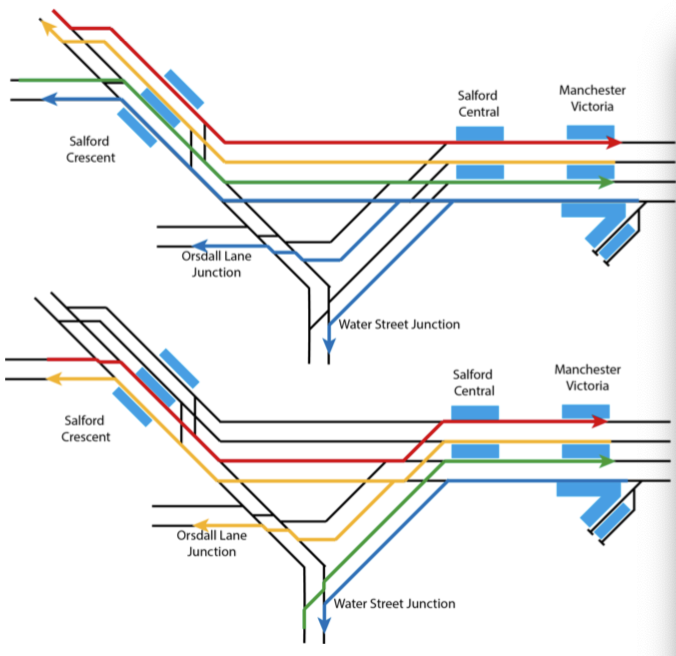
The routes from Wigan and Bolton converge at Windsor Bridge North Junction before arriving at Salford Crescent station and its island platform with two faces. Trains from either can go towards Victoria and Piccadilly (via Castlefield) at Windsor Bridge South Junction. Potential answers here include remodelling the north junction to make it grade-separated, adding an extra platform and track to allow more parallel moves. Another option changes services so that trains from Wigan go towards Piccadilly and trains from Bolton head for Victoria. Extra tracks between Salford Crescent, Salford Central and Victoria would let more trains arrive and depart at the same time.
Victoria station is too small
Victoria station itself is a constraint. According to NR, it needs longer platforms and would benefit from mid-platform signals. On current TPRs, each platform can cope with a train every five minutes in the same direction. But NR’s report admits that trains arrive at Victoria less than five minutes apart. It adds: “If the platforms were lengthened to enable a 6-car train to stand either side of the mid-platform signal this would also increase the platform capacity of the station without the restrictions imposed by permissive working.”
NR adds that the number of trains at the station means there is not time to cope with terminating trains so eastbound trains run on to Rochdale or Stalybridge. However, single-lead ladder junctions limit crossing capacity east of the station. Adding crossovers here could help, NR notes. Help might come from adding reversing sidings east of Victoria. This would cut the number of trains running on towards Rochdale or Stalybridge with might ease the constrains of those single ladder junctions.
Single lines limit capacity
Further afield, the sections of single line between Blackburn and Bolton force trains to be evenly spaced at Manchester, according to NR, which means that any changes in the centre have knock-on effects.
South of the city, platform capacity at Manchester Airport station becomes a problem as more operators run longer trains. This is despite work over recent years to add and lengthen platform here.
Whatever comes from NR’s second report in the spring, it looks likely that passengers around Manchester and the wider North of England faces several more years to disruption from today’s faulty timetables and then several years of disruption from rebuilding tracks, junctions and stations.
Castlefield corridor constraints, potential improvements and timescales
High impact
- Timetable planning rules do not reflect real train running. Review and amend. S.
- Too little infrastructure/too many trains. Reduce the number of trains. M-L.
- Too many conflicting train movements. Remove or divert services to cut conflicts. S.
Medium impact
- Junction layouts at Salford Crescent create too many conflicting moves. Redesign station and junctions to cut conflicts. M-L.
- Lack of flexibility on routes feeding into Manchester. Provide overtaking capability on feeder routes. M-L.
- Irwell Street and Deal Street Junctions have a shortage of parallel moves. Redesign junctions to allow parallel moves. M-L.
- Insufficient capacity at Manchester Victoria station. Install mid-platform signals to cut re-occupation time. M-L.
Low impact
- Shortage of platform capacity at Manchester Airport station. Provide more or longer platforms. M-L.
- Single-line sections between Bolton and Blackburn. Cut the number of conflicting moves Blackburn trains make or redouble tracks. M-L.
- Inconsistent headways on routes in and out of Manchester. Resignal to give consistent headways. M-L.
- Shortage of parallel moves on eastern approach to Manchester Victoria. Provide extra crossovers. M-L.
Source: Network Rail. Notes: S – short-term, M – medium-term, L – long-term.
This article first appeared in RAIL 895, published January 2 2020.
